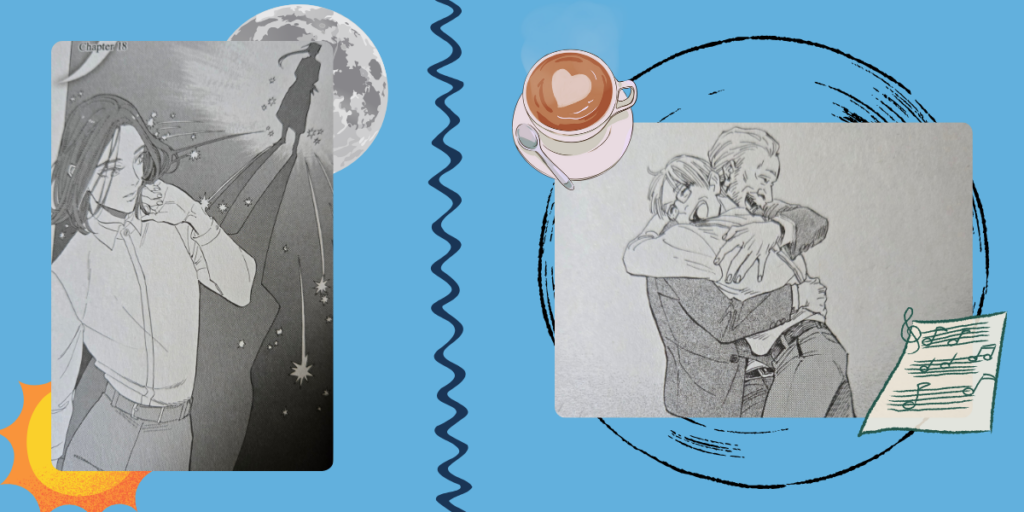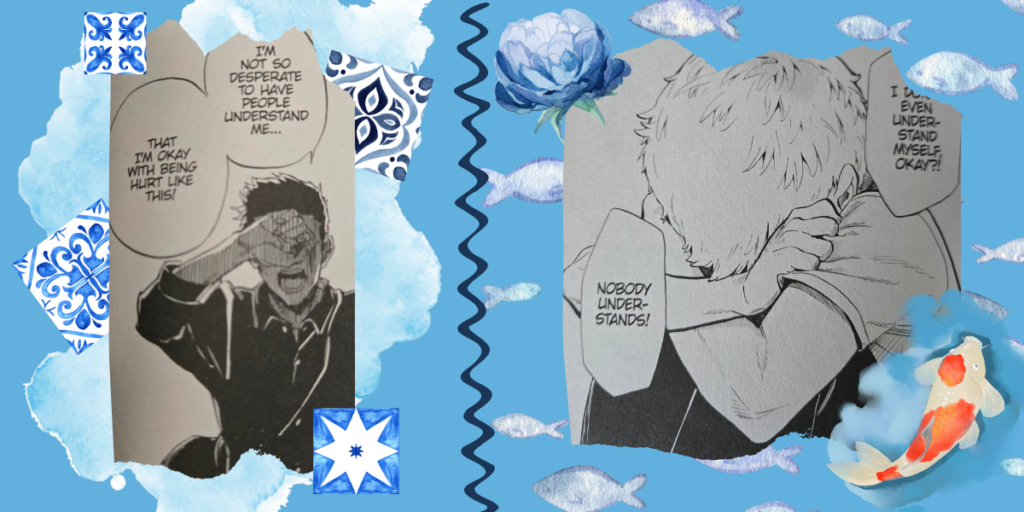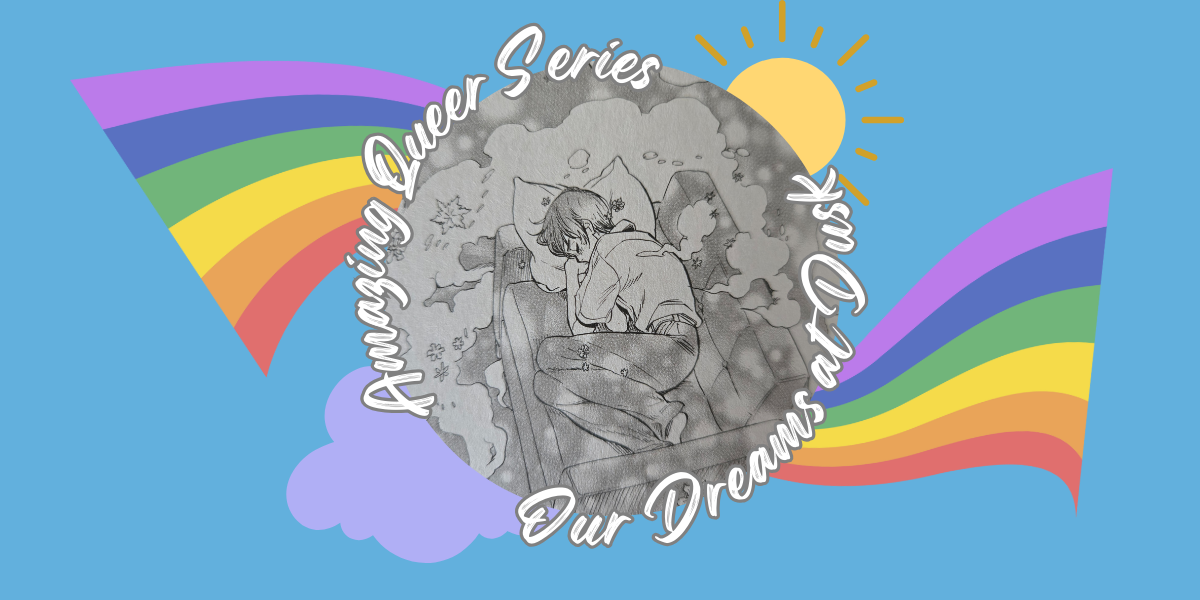As a queer writer, I’m always on the lookout for new pieces of queer work. Whether that be new books, shows, comics, or anything else that catches my eye. Unfortunately it can be difficult to find a queer series that both contains great representation, engaging plot, and interesting characters. Often I find myself sacrificing one or more to find something new. However, that isn’t always the case. Over the years I’ve found many, many series that I love. But one of my favorite queer series of all time would have to be Our Dreams at Dusk.
Description and Plot
Described as, “a beautiful tale of coming out and coming of age” on the back of the physical copy currently in my hands, Our Dreams at Dusk is a four volume manga series. Following high schooler Tasuku Kaname, who has possibly been outed as gay, is now struggling to figure out how he will live on. But after watching a mysterious figure seemingly jump to their death, he finds his way to a drop-in center. Which becomes one of the main settings throughout the series.
Created by Yuhki Kamatani and published by Seven Seas entertainment, Our Dreams at Dusk is one of the most beautiful queer series I’ve read. Filled with both joy and heartbreak. The kind of story that snatches your heart right from your chest and holds it tight. Bringing conflicting tears to your eyes just remembering it. It’s realistic in the most wonderful and horrible way, speaking essential human truths on the queer experience.
It’s the first recommendation I give anybody who asks me for something new. I love this series for many reasons, some of which I’ll outline here, and it will always hold a special place in my heart. I hope this will encourage you all to take a chance and read it for yourself!
Realism
One of the biggest reasons I love Our Dreams at Dusk so much is how realistic its depictions of queerness are. Oftentimes, queer series are written through a lens of the straight experience or what cishet people value as the most important parts of queer experience. For example, the “coming out,” typically being the climax of the piece. While coming out is undoubtedly an important experience for queer people, especially when doing so for the first time, it’s not a one and done deal. Queer people constantly have to come out, they constantly reaffirm their identity to groups of people. And eventually it can become so obvious and ingrained in our lives that we forget other people don’t know.
Tasuku coming out along with other characters make up a good chunk of the plot points throughout the story, but it is not the only depiction of queerness. Every queer person is in a different part of their journey. Whether that be the new, baby queer like Tasuku, just coming to terms with his sexuality and desperately trying to help others. To characters who are still struggling to figure out who they are and their place in the world like Shuuji Misora. Even characters like Ilya Tchaiko, who have long settled into their identity and have the experience to back up their wisdom.

Having all these different characters with different levels of life experience displays a fuller range of queer experiences. Showing how time helps mold you into who you are.
I can’t speak for other queer people, but as an agender aroace I found Someone-san to be a breath of fresh air. When they first presented her, I rolled my eyes and thought to myself, “great, another unrealistic depiction where the only way we exist is if we’re inhumane. Because of course being in love is the qualifier for being human.” But instead I found the most realistic depiction I’ve ever seen in fiction. A depiction so vividly painted and expressed that it put words to feelings I had but couldn’t explain.
I lost my breath as she explained the metaphor of everyone having labels that allowed them passage onto different ships. And feeling left behind on the shore. I sobbed as Tasuku took her hand and told her, “you’re warm. You’re here. And that’s enough for me,” a sentiment I’d been waiting and waiting to hear from the people in my life.
And as a trans person, I related with Shuuji’s plight to figure out his gender identity. Of trying new ways to express myself and feeling a mix of relief and shame. And to Natsuyoshi Utsumi and him struggling with the misunderstandings of friends who claim to care and accept him, but end up hurting us anyways. But I could also relate to Tasuku, new to queerness, eager to put a label on everything, and bring my friends to the same “enlightenment” I’d reached. Not yet understanding that we as queer people can’t lead people on their journey. Instead, we have to watch them struggle. Instead, we walk beside them and support them every step of the way. I could relate to Saki’s conundrum of trying to live as authentically as possible but staying closested out of fear.

There were so many other experiences I could relate to, every character depicted perfectly. Every character so life-like that I almost felt like I could talk to them through the page. That alone was enough to keep me hooked and put this towards the top of my favorite’s list.
Characters
Speaking of characters, the characters themselves are another reason why I would call this queer series a masterpiece. They’re not only some of the most realistic characters I’ve ever had the pleasure of meeting, but so incredibly varied. Varied in a way I rarely get to see in media. In the majority of works there is a queer character or a queer character and their partner. But in Our Dreams at Dusk, the majority of the cast is queer in some way. And the variations in that queerness is a giant leap forward. There are gay characters, lesbian characters, trans characters, and even an aroace.
While there are definitely more identities that exist beyond those (bisexuality, pansexuality, etc…), it’s rare that this many identities are shown and explored in such depth. And for the length and amount of characters, I feel like there is an impressive amount of representation packed into this manga.
And beyond their queerness, I found all these characters to be believable and charming in their own ways. They all have their own interests. Such as Ilya’s love of classical music or Natsuyoshi’s love of biking. And their own personality quirks. Such as Haruko Daichi’s hot-headed nature and even Shuuji’s bluntness. All these quirks and traits add up to make characters that are fun to get to know. And easy to get invested in as we watch their ups and downs and learn more about them.
Length
I actually really enjoy that it is only four volumes long. While there’s nothing like a long series that I can sink my teeth into, I also enjoy something I can sit down and take a day to enjoy. For me, Our Dreams at Dusk is one the latter. When I’m feeling uninspired or need an escape from the real world, I can set aside a few hours and fall back into the world Kamatani painstakingly created.
It also makes it a great recommendation to give to others. Our Dreams at Dusk is short queer series that it wouldn’t uproot someone’s life to read. They can bring the manga along with them in their bag or on their phone, reading it on the go or when there’s a free moment. And since it’s shorter, it’s not as intimidating to take on. Especially for people who haven’t ever read or even heard of manga.
The length of this series is definitely a plus in my mind!
Art and Metaphor
I’m no artist but even I can appreciate how beautifully this manga is drawn. And the way Kamatani uses the beautiful art to express the different emotions the character’s feel is incredible. Watching Tasuku explode into shards of glass when he sees how happy Saki and Haruko are together is breathtaking. Nothing displaying the heartbreak and fear as he wonders, “why (not) me?” better. Or watching him breathe out a winter storm that represents his inner hopelessness and turmoil.

The way Kamatani blends art and metaphor is worth a whole other article. And it deserves to be seen and appreciated by even more eyes. So pick up a copy yourself and prepare to immerse yourself in an amazing, life-changing journey!

Leave a Reply